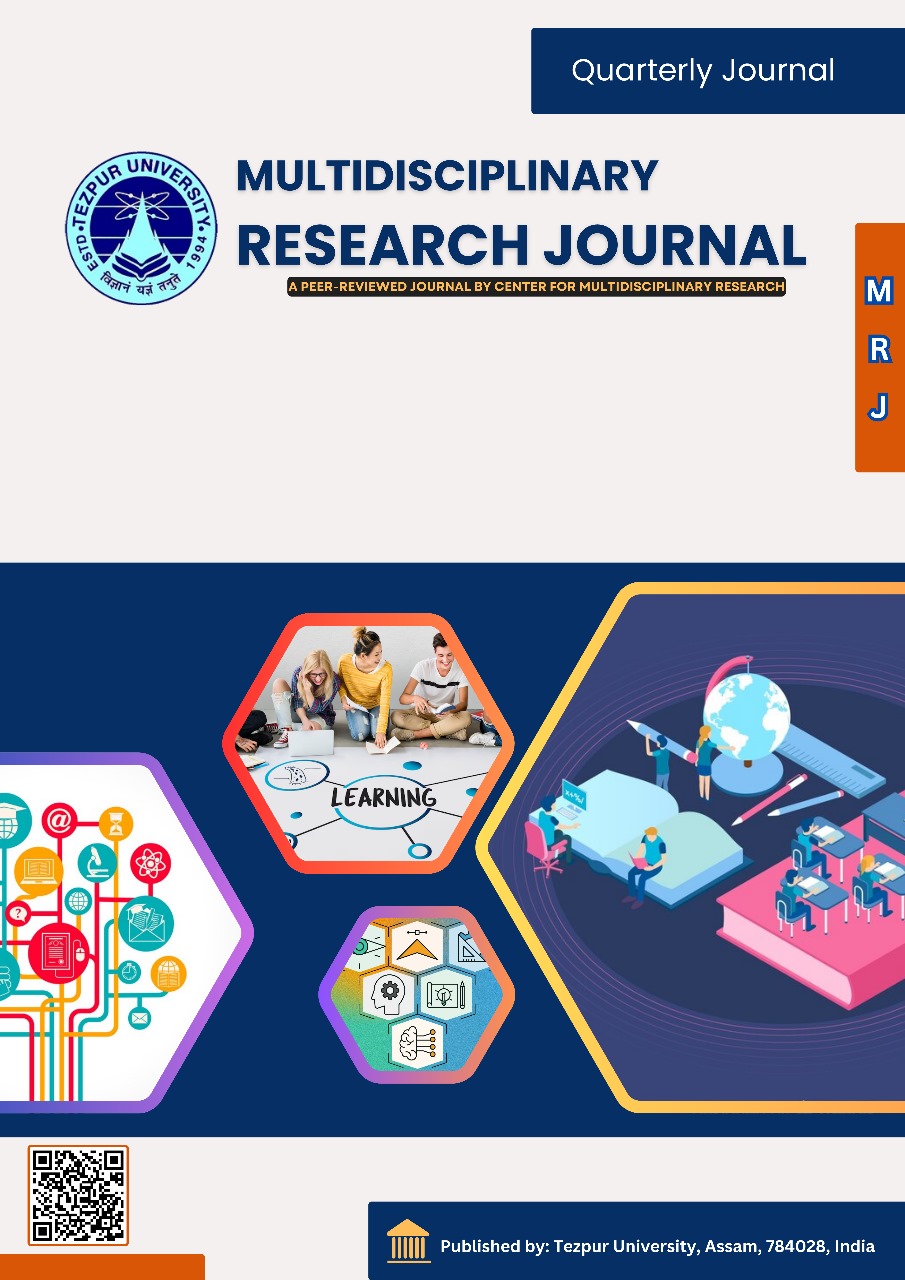Near Infrared Spectroscopy and Machine Learning for Non-Destructive Estimation of Ageing of Komal Chaul
DOI:
https://doi.org/10.63635/mrj.v1i2.23Keywords:
Nondestructive, aged-rice, Komal Chaul, ready-to-eat, Machine LearningAbstract
Komal Chaul is a traditional form of a parboiled rice product from rice varieties indigenous to the state of Assam and it constitutes a culturally significant dish served during the auspicious occasions. Ageing impacts its rehydration properties diminishing its value as a no-cooking rice product. To empower the consumers in selecting Komal Chaul of desired rehydration qualities, this study focused on developing a non-destructive tool based on near-infrared spectral data coupled with machine learning (ML) algorithm for distinguishing the aged Komal Chaul. An NIR spectral library of KomalChaul samples was created, covering the spectral range of 740–1050 nm for samples stored for a period up to one year under ambient conditions. The methodology involved spectral preprocessing to enhance data quality, followed by partial least squares (PLS) regression modeling to predict storage time. Statistical metrics, including regression coefficient (R²), relative error percentage (REP), and root mean squared error (RMSE), were used to validate the model. Feature selection based on coefficient weightage was performed to identify key wavelengths contributing to time prediction. Classification models, including LDA, KNN, CART, Naïve Bayes, SVM, and Random Forest, were employed to categorize samples into aging periods of 1, 3, and 6 months. Partial Least Squares (PLS) regression models predicted the ageing time with a validation score R2 of 0.897 and RMSE of 19.41 days. Optimized with wavelength selection, the PLS regression model achieved significant accuracy in estimating the ageing time, with a prediction score R2 of 0.89 and RMSE of 2.01 days. Similarly, using the same approach for cooking quality prediction resulted in satisfactory performance, achieving a validation R² of 0.79. Classification models further enhanced prediction accuracy, with the Random Forest model attaining the highest accuracy of 92% for six-month interval classifications. These results underscore the potential of integrating NIR spectroscopy and machine learning for efficient, non-destructive quality assessment of Komal Chaul, supporting its commercialization as a value-added traditional food product
Downloads
References
[1] Pangging, G.; Sharma, M.B.; Sharma, C.L.; Rai, N.; Gogoi, J. Status of Geographical Indications in the Northeast region of India. J. Intellect. Prop. Rights2023, 28, 304–311, https://doi.org/10.56042/jipr.v28i4.68113.
[2] Wahengbam, E.D.; Tongbram, T.; Hazarika, M.K. Drying characteristics of ready-to-eat komalchawal rice: processing and modeling. J. Food Sci. Technol.2020, 57, 1698–1709, https://doi.org/10.1007/s13197-019-04199-1.
[3] Wahengbam, E.D.; Hazarika, M.K. Quality of ready-to-eat komalchawal produced by brown rice parboiling method. J. Food Sci. Technol.2019, 59, 187–199, https://doi.org/10.1007/s13197-021-05001-1.
[4] Dutta, H.; Mahanta, C. Traditional parboiled rice-based products revisited: Current status and future research challenges. Rice Sci.2014, 21, 187–200, https://doi.org/10.1016/S1672-6308(13)60185-1.
[5] Wahengbam, E. D., Das, A. J., Green, B. D., Shooter, J., & Hazarika, M. K. Effect of iron and folic acid fortification on in vitro bioavailability and starch hydrolysis in ready-to-eat parboiled rice. Food chemistry, 2019, 292, 39-46, https://doi.org/10.1016/j.foodchem.2019.04.044.
[6] Wahengbam, E. D., Tongbram, T., & Hazarika, M. K. Drying characteristics of ready-to-eat komalchawal rice: processing and modeling. Journal of Food Science and Technology, 2020, 57, 1698-1709.
[7] Gambhir, M. Smart India Hackathon 2022. Ministry of Education Innovation Cell. Available online: https://www.sih.gov.in/sih2022PS (accessed on 2 January 2025).
[8] Pasquini, C. Near infrared spectroscopy: A mature analytical technique with new perspectives – A review. Anal. Chim. Acta2018, 1026, 8–36, https://doi.org/10.1016/j.aca.2018.04.004.
[9] Jha, S.N.; Ruchi, G. Non-destructive prediction of quality of intact apple using near infrared spectroscopy. J. Food Sci. Technol.2010, 47, 207–213, https://doi.org/10.1007/s13197-010-0031-7.
[10] Jha, S.N.; Jaiswal, P.; Narsaiah, K.; Kumar, R.; Sharma, R.; Gupta, M.; Bhardwaj, R.; Singh, A.K. Authentication of Mango Varieties Using Near-Infrared Spectroscopy. Agric. Res.2013, 2, 229–235, https://doi.org/10.1007/s40003-013-0075-0.
[11] Jha, S.N. Near Infrared Spectroscopy. In Nondestructive Evaluation of Food Quality: Theory and Practice; Narsaiah, K., Ed.; John Wiley & Sons: Hoboken, NJ, USA, 2010; pp. 141–212, https://doi.org/10.1002/9780470602636.ch5.
[12] Zhanming, L.; Jiahui, S.; Yinxing, M.; Yue, Y.; Xueming, H.; Yuanxin, G.; Jinxin, D.; Hao, D. Identification of aged-rice adulteration based on near-infrared spectroscopy combined with partial least squares regression and characteristic wavelength variables. Food Chem.: X2023, 17, 100539, https://doi.org/10.1016/j.fochx.2023.100539.
[13] Li, M.; Qian, Z.; Shi, B.; Medlicott, J.; East, A. Evaluating the performance of a consumer scale SCiO™ molecular sensor to predict quality of horticultural products. Postharvest Biol. Technol.2018, 145, 183–192, https://doi.org/10.1016/j.postharvbio.2018.07.017.
[14] Dutta, H.; Mahanta, C.L. Laboratory process development and physicochemical characterization of a low amylose and hydrothermally treated ready-to-eat rice product requiring no cooking. Food Bioprocess Technol.2014, 7, 212–223, https://doi.org/10.1007/s11947-013-1061-0.
[15] Huang, F., Peng, Y., Li, L., Ye, S., & Hong, S. (2023). Near-infrared spectroscopy combined with machine learning methods for distinguishing the storage years of rice. Infrared Physics & Technology, 2023, 133, 104835.https://doi.org/10.1016/j.infrared.2023.104835.
[16] Song, J., Yu, Y., Wang, R., Chen, M., Li, Z., He, X., Ren, Z., & Dong, H. The identification of aged-rice adulteration by support vector machine classification combined with characteristic wavelength variables. Microchemical Journal, 2024, 199, 110032. https://doi.org/10.1016/j.microc.2024.110032.
[17] Xu, L.; Zhou, Y.P.; Tang, L.J.; Wu, H.L.; Jiang, J.H.; Shen, G.L.; Yu, R.Q. Ensemble preprocessing of near-infrared (NIR) spectra for multivariate calibration. Anal. Chim. Acta2008, 616, 138–142, https://doi.org/10.1016/j.aca.2008.03.024.
[18] Shi, S.; Feng, J.; Yang, L.; Xing, J.; Pan, G.; Tang, J.; Jiang, Y. Combination of NIR spectroscopy and algorithms for rapid differentiation between one-year and two-year stored rice. Spectrochim. Acta A2023, 122343, https://doi.org/10.1016/j.saa.2023.122343.
[19] Teye, E.; Amuah, C.L.Y.; McGrath, T.; Elliott, C. Innovative and rapid analysis for rice authenticity using hand-held NIR spectrometry and chemometrics. Spectrochim. Acta A2019, 217, 147–154, https://doi.org/10.1016/j.saa.2019.01.049.
Downloads
 Abstract Display: 402
Abstract Display: 402  PDF Downloads: 226
PDF Downloads: 226 Published
Issue
Section
License

This work is licensed under a Creative Commons Attribution-NonCommercial 4.0 International License.
Copyright © Author(s) retain the copyright of this article.




